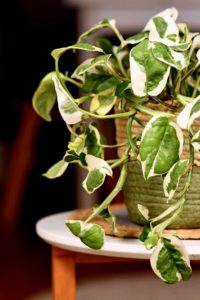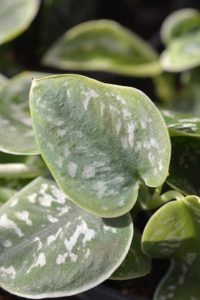Quick Guide: 8 Types of Pothos
There are various types of Pothos and although some of the differences can be obvious, there is an instance where it is subtle. Pothos is an easy-to-care plant with easy propagation, high tolerance to low lighting, and have minimal maintenance.
Disclaimer :
- Our content does not constitute a medical consultation. If you have a medical problem you should seek advice from a doctor and other health care professionals.
- There may be links to products and services recommended on here that are affiliate links and I may earn if you click on them, AT NO EXTRA cost to you.
Table of Content
i) Jade Pothos
 Jade Pothos has solid green foliage. Furthermore, with proper care, the foliage will have deep green color as a sign of it thriving. This is one of the types of pothos that is common and easy to find in a store. Since it is plain green with no distinct markings, it is always mistaken as philodendron.
Jade Pothos has solid green foliage. Furthermore, with proper care, the foliage will have deep green color as a sign of it thriving. This is one of the types of pothos that is common and easy to find in a store. Since it is plain green with no distinct markings, it is always mistaken as philodendron.
ii) Golden Pothos
Golden Pothos is also known as Devil’s Ivy simply because it is almost impossible to kill. The plant thrives in many conditions and in addition, is very easy to propagate. Furthermore, it is also known as a money plant in India as well as southeast Asia.
almost impossible to kill. The plant thrives in many conditions and in addition, is very easy to propagate. Furthermore, it is also known as a money plant in India as well as southeast Asia.
This plant is excellent in removing impurities in the air and therefore is a good choice as an indoor plant. However, Devil’s Ivy is also poisonous therefore, keep it away from the reach of children or pets. There is a high risk of oral irritation, excessive drooling, and vomiting if consumed.
iii) Marble Queen Pothos
 This plant is quite similar to Golden Pothos except for the color of their foliage. Marble Queen Pothos leaves are white-ish and lighter colored compared to Golden Pothos having a dark green color. So as a rule of thumb, Golden Pothos is green and yellow whereas Marble Queen Pothos is green and white. Compared to other types of pothos, Marble Queen is slow in growth.
This plant is quite similar to Golden Pothos except for the color of their foliage. Marble Queen Pothos leaves are white-ish and lighter colored compared to Golden Pothos having a dark green color. So as a rule of thumb, Golden Pothos is green and yellow whereas Marble Queen Pothos is green and white. Compared to other types of pothos, Marble Queen is slow in growth.
iv) Neon Pothos
Neon Pothos is light green and vibrant in color hence the name. This plant among other types of pothos is easy to care for and will spice up your home as an indoor plant.
name. This plant among other types of pothos is easy to care for and will spice up your home as an indoor plant.
v) Manjula Pothos
 Manjula Pothos just like its family is easy to grow and care for. It is easily recognized with its large white markings on the foliage. Not to be confused with Marble Queen, The white markings in Manjula looks like it is drawn rather than Marble Queen where it looks like a splash of paint.
Manjula Pothos just like its family is easy to grow and care for. It is easily recognized with its large white markings on the foliage. Not to be confused with Marble Queen, The white markings in Manjula looks like it is drawn rather than Marble Queen where it looks like a splash of paint.
vi) Pearls and Jade Pothos
Pearls and Jade Pothos has its origin in Marble Queen Pothos and in addition, we can say that it was born at the University of Florida. Pearls and Jade Pothos have distinct splash-like markings on their foliage.
and in addition, we can say that it was born at the University of Florida. Pearls and Jade Pothos have distinct splash-like markings on their foliage.
vii) N-Joy Pothos
 N-Joy Pothos also has its origin from Marble Queen and is part of a breeding program. This plant has distinct and obvious white markings on its foliage.
N-Joy Pothos also has its origin from Marble Queen and is part of a breeding program. This plant has distinct and obvious white markings on its foliage.
viii) Silver/Satin Pothos
Silver Satin Pothos foliage has its foliage appeared to be painted. The satin-like texture is charming and suitable to be made an indoor plant. Just like other types of pothos, it is a fast grower and high tolerant to low lighting. Although most usually regard this plant as pothos, actually it is not really a pothos as this plant is from the Scindapsus family.
painted. The satin-like texture is charming and suitable to be made an indoor plant. Just like other types of pothos, it is a fast grower and high tolerant to low lighting. Although most usually regard this plant as pothos, actually it is not really a pothos as this plant is from the Scindapsus family.
2. Care for Pothos
Pothos is an easy plant to care for. Nevertheless, if these points below are taken care of, then the plants may grow healthier with lush green foliage.
i) Soil
Make sure to have proper drainage to prevent root rot. Furthermore, as an option, you can also use a peat pellet. For beginners, get yourself a potting mix like this one here.
ii) Fertilizer
I use Coffee Fertilizer once in 2 weeks. Make sure to spread it away not too close to the plant to avoid burning. Fertilizer made of coffee is my choice since it is organic and provides complete nutrients for plants, vegetables, flowers, and fruits. I suggest an organic fertilizer like this one here.
iii) Humidity
Pothos is tolerant to any condition but what they really like is in the range of 50~70%. (Get your humidity checker here.) Hence, it is a good idea to put them in the bathroom because they can thrive in high humidity.
iv) Lighting
Pothos prefers Indirect but bright lighting, as a result, makes this a perfect choice as an indoor plant. Nevertheless once in a while, it would be a great idea too to place it outdoor under a shade.
v) Pests
Common problems usually involve scale and mealybugs. Mealybugs is white in color and looks like a tiny cotton ball. Scale pest, as its name suggests will appear on the stem of the plant and made it look scally. It is light yellow in color and the common treatment is to prune the affected area. You can use a neem oil spray to control pests and importantly, use it in the late evening or early morning.
vi) Propagating Pothos
Pothos is not difficult to propagate. All need is to make a cutting below the root node so that the cuttings are ready to be planted. If you make a cutting without the root, you may need to use a rooting hormone. Once a medium is chosen, the plant prefers to stay in that medium. If you use water as a medium, then it should be left in water.
vii) Repotting Pothos
You might want to repot once in a year in a bigger pot to allow growth. Once, my plant has its root infected so what I did was gently remove it from the soil, gently wash the roots under slow running water. Make sure all the visible fungus is washed away then replant it in new soil and Voila! It is restored!
3. Frequently Asked Questions
i) Why does Pothos leave Turns Yellow?
This can be due to overwatering. Pothos does not require a lot of water. Furthermore, if the soil is always alternating from really dry to wet from an improper watering schedule, it will create stress and the leaves will turn yellow.
ii) Is Devil’s Ivy Poisonous to humans
Yes, it is poisonous when ingested and may cause irritation to the mouth area. Furthermore, if you have pets, make sure the plants are unreachable by them. Personally I myself like to hang the plants since it looks gorgeous seeing the vines dangling.
iii) Can I plant different types of pothos together?
Since Pothos is easily propagated by cuttings, it opens up possibilities for you to experiment. You may try Satin + Marble Queen although from what I was told, satin pothos is more cooperative compared to Marble Queen. Why not try Satin + Golden Pothos. However, satin pothos has smaller leaves therefore it might get blocked by Golden Pothos.
iv) How does a philodendron differ from a pothos?
Although it is similar and always mistaken, the easiest way to tell the difference is by the shape of the leaves. Philodendron leaves look like a heart shape in comparison to Pothos. Even though they are both able to tolerate low lights, pothos will tolerate better. If Philodendron has low exposure to light, it will grow smaller leaves compared to pothos where it will take more time for this to happen.
4. Ideas for Pothos as indoor plants
Pothos is a creeper plant and as a result, offers many decoration opportunities.
i) Coco Coir Pole
It is actually nice to see your pothos in a vertical arrangement. Plus there will be less trimming too. You can use a coco coir pole like this one here.
ii) Hanging Planters
Why not plant it high in a hanging planter? In addition, it is beautiful when the vines are long enough and dangling.
However, if you feel more adventurous, why not try this DIY for yourself. Complete tutorial in this video.
Share this on :

